Family: Tenthredinidae
Family common name: common sawflies
Subfamily: Nematinae
Tribe: Nematini
Genus: Dineura Dahlbom, 1835
Subgenera: none
The Tenthredinidae are the most species-rich family and are found throughout the world, in all continents but Antarctica. They are known as the “common sawflies.” They can generally be recognized by a cylindrical body and long, segmented antennaeantenna:
the sensory organ emerging from the front of the head, usually between the compound eyes and above the clypeus; includes the flagellum, scape and pedicel
 . Otherwise, they come in a variety of colors, sizes, and forms (Goulet 1992Goulet 1992:
. Otherwise, they come in a variety of colors, sizes, and forms (Goulet 1992Goulet 1992:
Goulet H. 1992. The genera and subgenera of the sawflies of Canada and Alaska: Hymenoptera. Symphyta. The insects and arachnids of Canada. Part 20. Agriculture Canada Publication.).
Nematinae is the second-largest subfamily of Tenthredinidae, with over 1,250 species (Prous et al. 2014Prous et al. 2014:
Prous M, Blank SM, Goulet H, Heibo E, Liston A, Malm T, Nyman T, Schmidt S, Smith DR, Varing;rdal H, Viitasaari M, Vikberg V, and Taeger A. 2014. The genera of Nematinae (Hymenoptera, Tenthredinidae). Journal of Hymenoptera Research 40: 1-69. " target="_blank">https://doi.org/10.3897/JHR.40.7442). They are most diverse in northern Eurasia and North America; only a few species occur in the Southern Hemisphere. Nematinae sawflies have a variety of feeding habits including external leaf feeding, leaf mining, and gall forming, and feed on a variety of hosts (Smith 2003bSmith 2003b:
Smith DR. 2003b. A Synopsis of the sawflies (Hymenoptera: Symphyta) of America south of the United States: Tenthredinidae (Nematinae, Heterarthrinae, Tenthredininae). Transactions of the American Entomological Society 129 (1): 1-45.).
The Nematinae have been subject to numerous revisions in recent years. As of 2021, there are no comprehensive keys to many of the North American species of Nematinae (Prous et al. 2014Prous et al. 2014:
Prous M, Blank SM, Goulet H, Heibo E, Liston A, Malm T, Nyman T, Schmidt S, Smith DR, Varing;rdal H, Viitasaari M, Vikberg V, and Taeger A. 2014. The genera of Nematinae (Hymenoptera, Tenthredinidae). Journal of Hymenoptera Research 40: 1-69. " target="_blank">https://doi.org/10.3897/JHR.40.7442). Because of changing taxonomy and extreme variability in morphology, identifying genera and species in the Nematinae may be more challenging than in other subfamilies of Tenthredindae. For this reason, knowing the host or behaviors of a specimen can be extremely helpful for identification within this subfamily.
Dineura is monotypicmonotypic:
describes having only one representative; ex. a genus that includes only one species
in North America. Dineura militaris is variable in color patterning, but is always black and orange and somewhat small in size (about 6–8 mm in length) (Smith 1975Smith 1975:
Smith DR. 1975. The sawfly genus Hemichroa Stephens : A review of species (Hymenoptera: Tenthredinidae). Insect Systematics and Evolution 6 (3-4): 297-302. https://doi.org/10.1163/187631275X00145).
There are 19 described species worldwide. One species occurs in North America (Taeger et al. 2018Taeger et al. 2018:
Taeger A, Liston AD, Prous M, Groll EK, Gehroldt T, and Blank SM. 2018. ECatSymmdash;Electronic World Catalog of Symphyta (Insecta, Hymenoptera). Program version 5.0 (19 Dec 2018), data version 40 (23 Sep 2018). Senckenberg Deutsches Entomologisches Institut (SDEI), Muuml;ncheberg. https://sdei.de/ecatsym/ Accessed: 28 Jan 2020.).
Subfamily characters
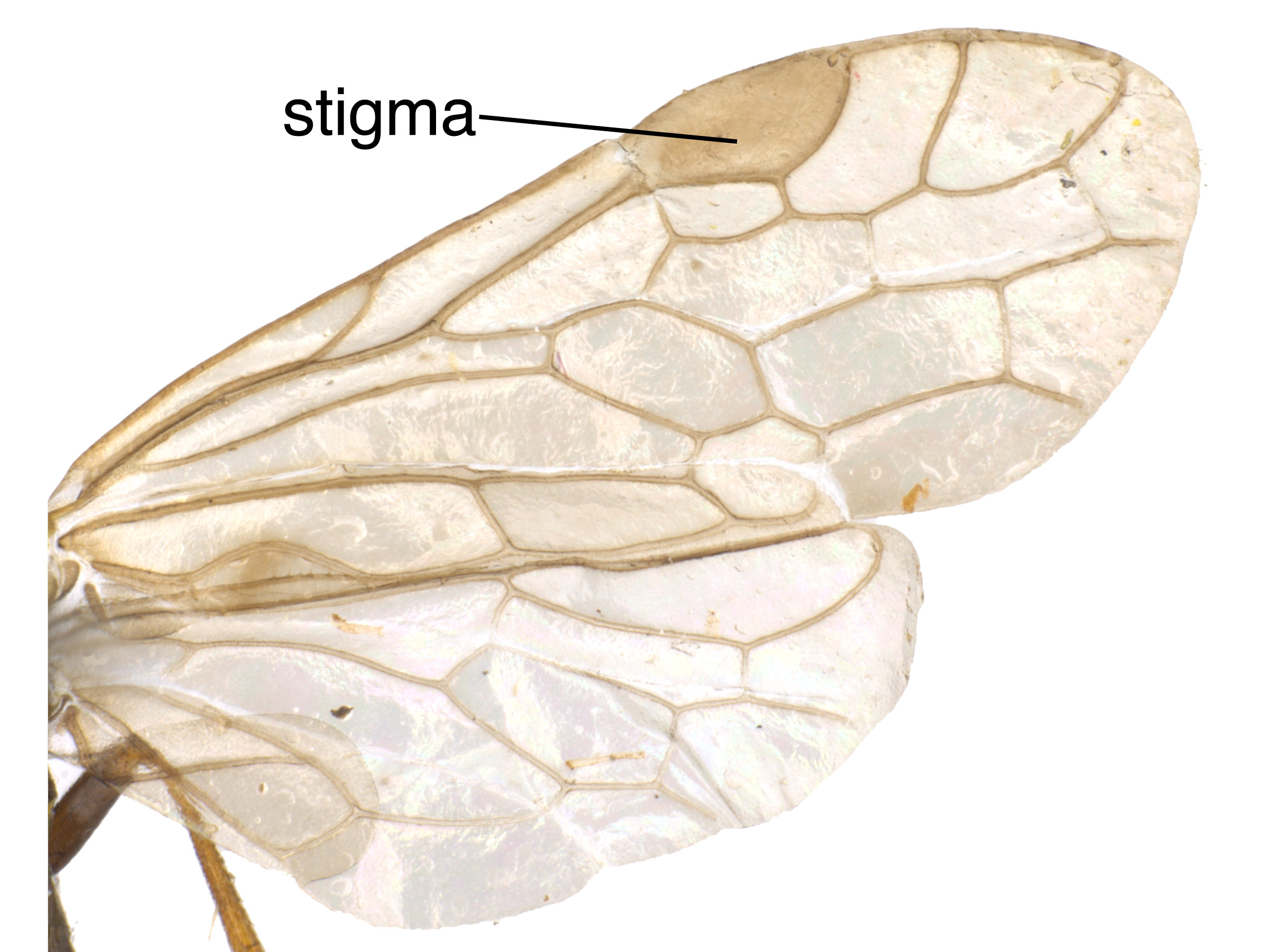 (Goulet 1992Goulet 1992:
(Goulet 1992Goulet 1992: vein 2m-cu meeting cellcell:
vein 2m-cu meeting cellcell: 1Rs above (Goulet 1992Goulet 1992:
1Rs above (Goulet 1992Goulet 1992:Genus characters
 deeply emarginated (Prous et al. 2014Prous et al. 2014:
deeply emarginated (Prous et al. 2014Prous et al. 2014: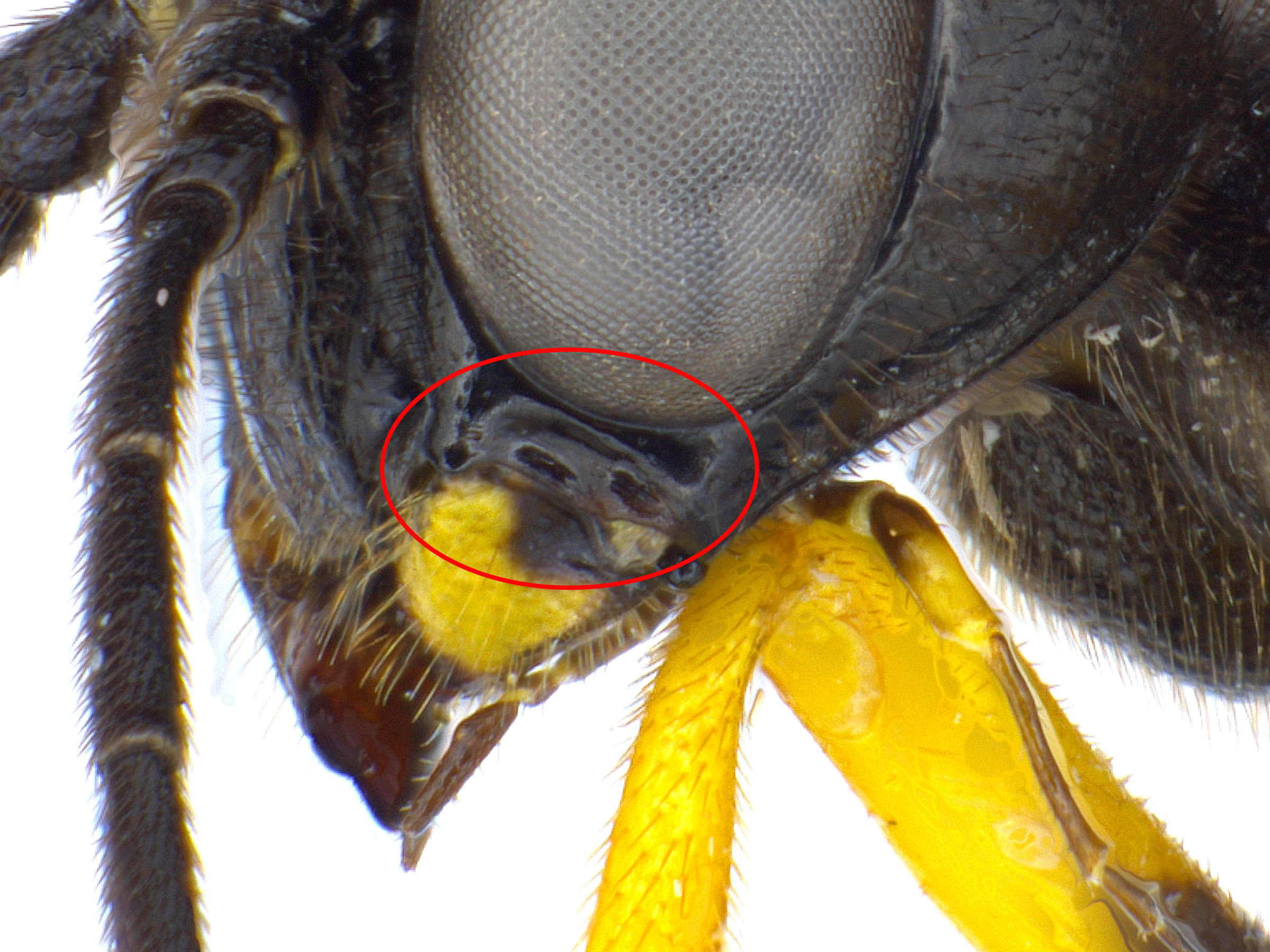 about equal to diameter of front ocellusocellus:
about equal to diameter of front ocellusocellus: (Prous et al. 2014Prous et al. 2014:
(Prous et al. 2014Prous et al. 2014: wider than long (Smith 1975Smith 1975:
wider than long (Smith 1975Smith 1975: veins M and Rs+M relatively widely separated on veinvein:
veins M and Rs+M relatively widely separated on veinvein: R (Goulet 1992Goulet 1992:
R (Goulet 1992Goulet 1992: vein 2A+3A curved upwards and meeting 1A, though often quite faint and hard to discern (Goulet 1992Goulet 1992:
vein 2A+3A curved upwards and meeting 1A, though often quite faint and hard to discern (Goulet 1992Goulet 1992: vein 2r-rs absent (Smith 1975Smith 1975:
vein 2r-rs absent (Smith 1975Smith 1975: vein 2A meeting 1A; basalbasal:
vein 2A meeting 1A; basalbasal: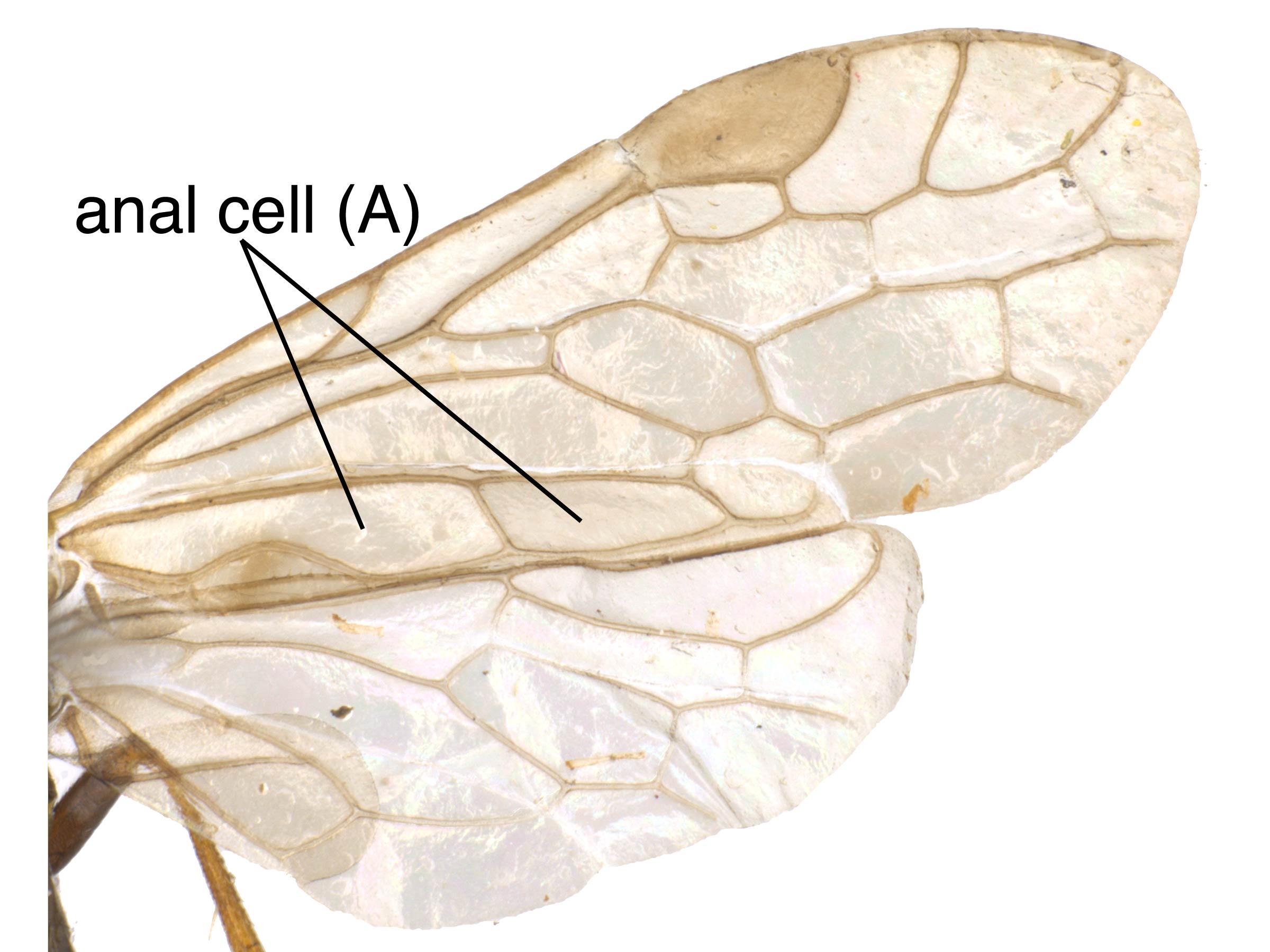 present (Goulet 1992Goulet 1992:
present (Goulet 1992Goulet 1992: spur without velum (Goulet 1992Goulet 1992:
spur without velum (Goulet 1992Goulet 1992: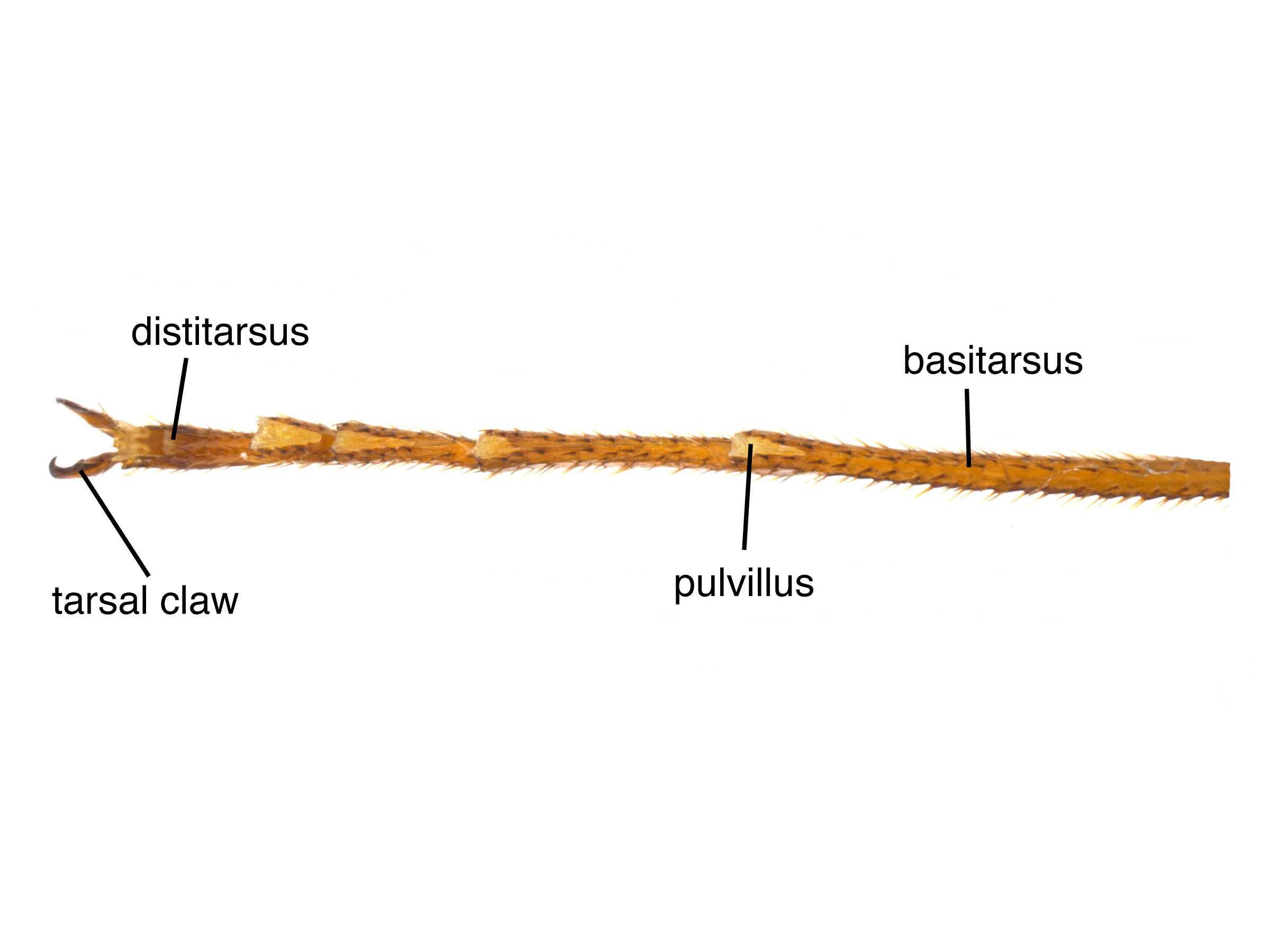 about 1/3 the length of the tarsomeretarsomere:
about 1/3 the length of the tarsomeretarsomere: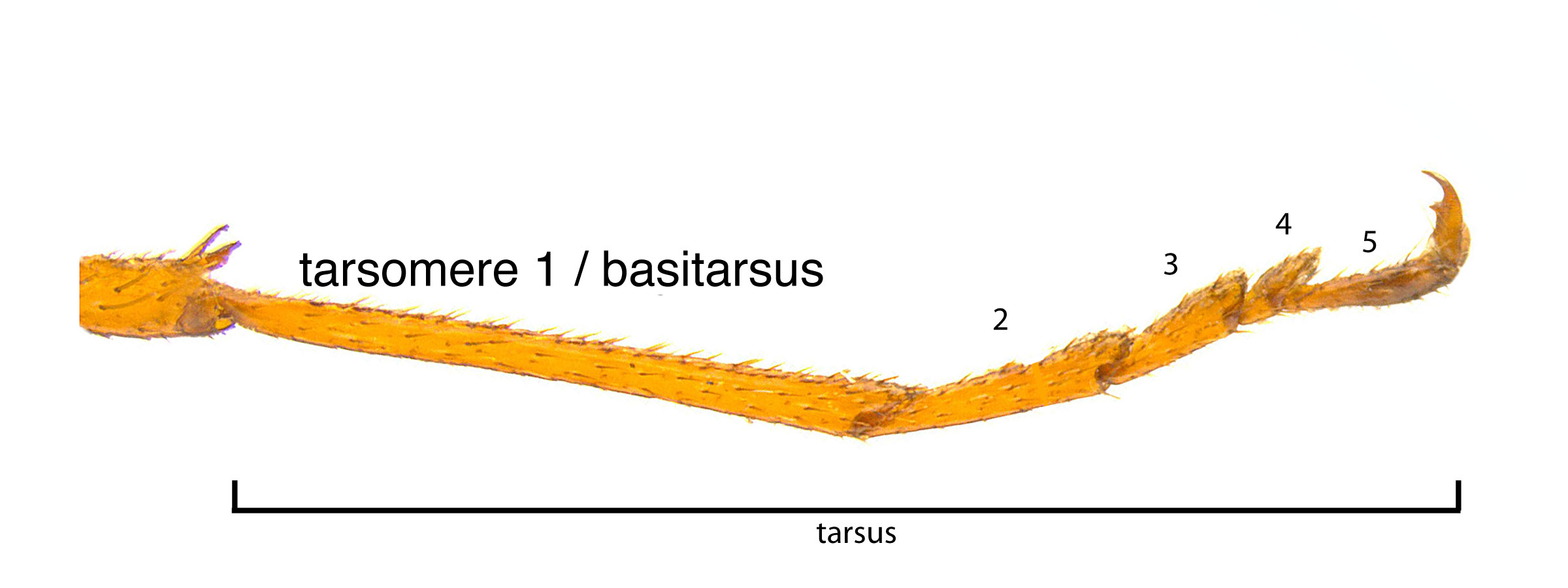 (Goulet 1992Goulet 1992:
(Goulet 1992Goulet 1992: about 3–6X as long as wide (Goulet 1992Goulet 1992:
about 3–6X as long as wide (Goulet 1992Goulet 1992:Dineura may be confused with other genera in the subfamily Nematinae — especially Hemichroa — but can be distinguished from it and most other genera that have fore wingfore wing:
the anterior wing of each pair of wings; usually the largest wing of the pair
 vein 2A+3A curved upwards by the long antennaeantenna:
vein 2A+3A curved upwards by the long antennaeantenna:
the sensory organ emerging from the front of the head, usually between the compound eyes and above the clypeus; includes the flagellum, scape and pedicel
 , the short pulvillipulvillus:
, the short pulvillipulvillus:
soft pads used for surface adhesion, located in sawflies on the first 4 segments of the tarsus
 , the absence of the velum on the larger fore tibialfore tibia:
, the absence of the velum on the larger fore tibialfore tibia:
the tibia of the fore leg
 spur, and the absence of fore wingfore wing:
spur, and the absence of fore wingfore wing:
the anterior wing of each pair of wings; usually the largest wing of the pair
 vein 2r-rs (Smith 1975Smith 1975:
vein 2r-rs (Smith 1975Smith 1975:
Smith DR. 1975. The sawfly genus Hemichroa Stephens : A review of species (Hymenoptera: Tenthredinidae). Insect Systematics and Evolution 6 (3-4): 297-302. https://doi.org/10.1163/187631275X00145, Goulet 1992Goulet 1992:
Goulet H. 1992. The genera and subgenera of the sawflies of Canada and Alaska: Hymenoptera. Symphyta. The insects and arachnids of Canada. Part 20. Agriculture Canada Publication.).
none
Dineura militaris feeds on Amelanchier (serviceberry) (Smith 1975Smith 1975:
Smith DR. 1975. The sawfly genus Hemichroa Stephens : A review of species (Hymenoptera: Tenthredinidae). Insect Systematics and Evolution 6 (3-4): 297-302. https://doi.org/10.1163/187631275X00145).
The larvaelarva:
the immature stage of holometabolous insects
 feed on the underside of the leaf. At maturity, the larvaelarva:
feed on the underside of the leaf. At maturity, the larvaelarva:
the immature stage of holometabolous insects
 fall to the ground to pupate or overwinter in the soil. Dineura militaris is univoltineunivoltine:
fall to the ground to pupate or overwinter in the soil. Dineura militaris is univoltineunivoltine:
describing an insect with a life cycle of one generation per year
(Smith 1975Smith 1975:
Smith DR. 1975. The sawfly genus Hemichroa Stephens : A review of species (Hymenoptera: Tenthredinidae). Insect Systematics and Evolution 6 (3-4): 297-302. https://doi.org/10.1163/187631275X00145).
World: The genus is known from North America, throughout Europe, Russia, China, Japan, and Thailand (Taeger et al. 2018Taeger et al. 2018:
Taeger A, Liston AD, Prous M, Groll EK, Gehroldt T, and Blank SM. 2018. ECatSymmdash;Electronic World Catalog of Symphyta (Insecta, Hymenoptera). Program version 5.0 (19 Dec 2018), data version 40 (23 Sep 2018). Senckenberg Deutsches Entomologisches Institut (SDEI), Muuml;ncheberg. https://sdei.de/ecatsym/ Accessed: 28 Jan 2020.).
North America: Dineura militaris occurs throughout the northern United States and Canada, and as far north as Alaska (Smith 1975Smith 1975:
Smith DR. 1975. The sawfly genus Hemichroa Stephens : A review of species (Hymenoptera: Tenthredinidae). Insect Systematics and Evolution 6 (3-4): 297-302. https://doi.org/10.1163/187631275X00145).
Map data from: GBIF.org (29 October 2019) GBIF Occurrence Download Hemichroa
Details about data used for maps can be found here.